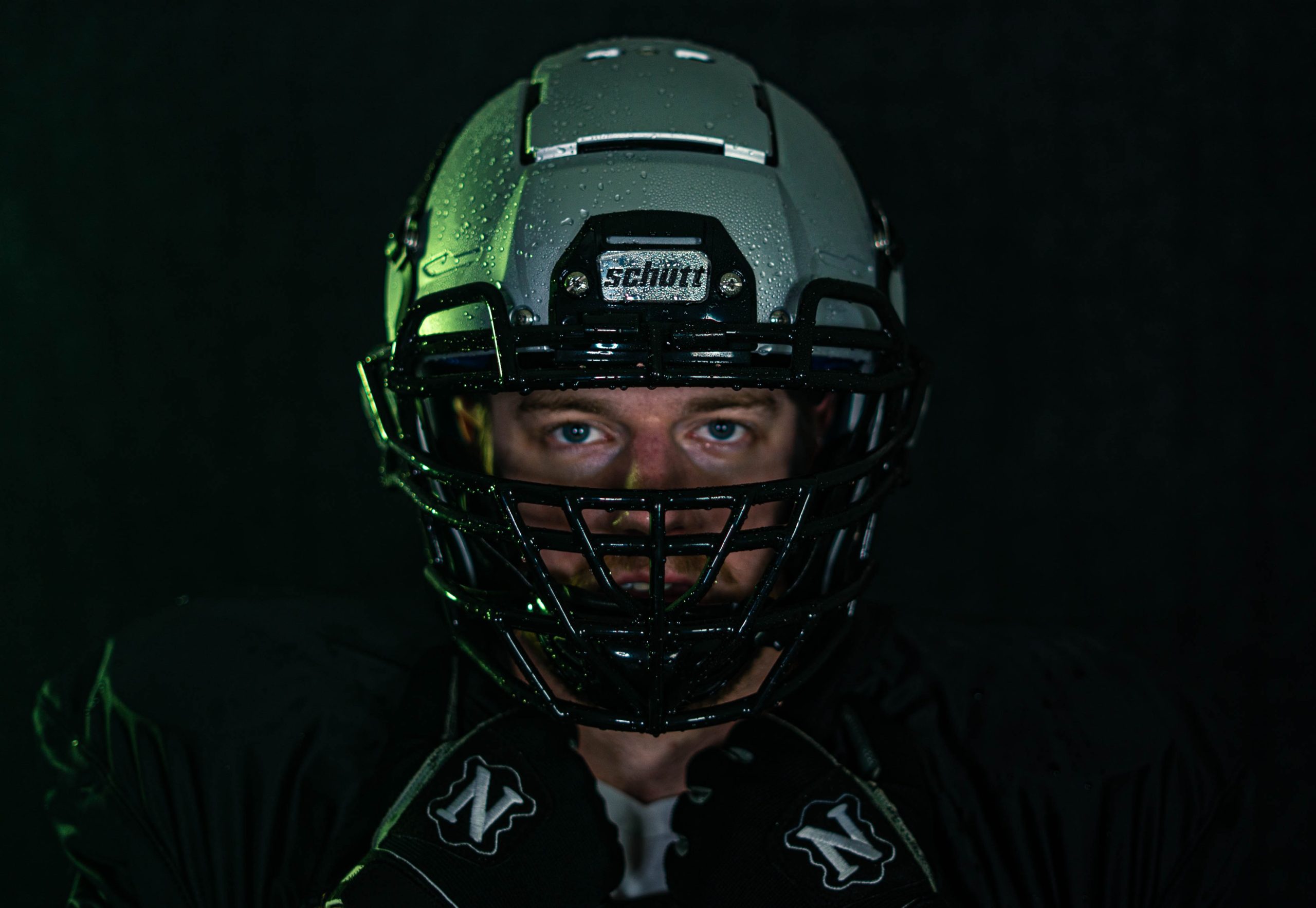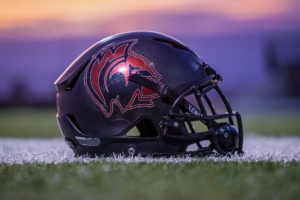Sometimes when watching an NFL game, it appears that a quarterback has an extra set of eyes on the field and as it would turn out, some of them do.
This “second set of eyes” comes from their head coach or offensive coordinator speaking to them through a speaker in their helmets. This is something that happens in most levels of football and today we will break down how this speaker system works and the rules around it.
Contents
- Who is allowed to have speakers in the NFL?
- Do college football players have speakers in their helmets?
- Rules for Headset Communication
- 1. High School
- 2. College
- 3. NFL
- Ways Coaches Communicate to Players Without Speakers
- Who is allowed to speak to the quarterback’s headset?
- How do coaches call plays when their headsets are broken?
- How do defensive players with headsets communicate plays to the team?
- How do quarterbacks communicate in a huddle offense?
- FAQ
- Summary
Who is allowed to have speakers in the NFL?
Before 2008, speakers were banned from being placed in helmets and teams would get their play calls from the sidelines.
However, in 2008, one on offense and one player on defense on each NFL team is allowed to have a speaker in their NFL helmets so they can communicate directly with the coaching staff.
Here is a great video on the history of radio connectivity inside NFL headsets:
Typically, this honor is bestowed upon the quarterback, so it makes calling and running offensive plays much easier.
However, any player is eligible to have the speaker in their football helmet although it wouldn’t make much sense to have any other player on offense besides the quarterback’s helmet have built-in speakers.
Do college football players have speakers in their helmets?
While speakers in football helmets make for a helpful and efficient way for coaches to communicate with their football players helmets even while they are on the field, they are illegal in college football.
As a result, college teams typically come up with creative ways to communicate plays quickly to the QB.
However, there have been a handful of major rule changes and other switch-ups in college football. The most recent major rule change was to give college players the right to make money through their image and likeness.
This has been a major positive for the players as it gives them an opportunity to make business moves while they are still in college.
Along with this, many teams will be making conference changes in 2024. With all of this change occurring in the past couple of years, there is a chance that speakers being added to a collegiate player’s helmet could occur as well
Rules for Headset Communication
Below are the rules for football players and headset communications at the different levels of football:
1. High School
In high school, just like in college, having a speaker inside the helmet of a player is not allowed. Despite this, there are some private leagues in which this practice is allowed. However, for public high school teams, speakers in helmets are not allowed.
2. College
As previously mentioned, headsets in helmets are also banned in college football as well. Though this is something that could change in the future, there have not been any rumors of the rule being changed yet.
3. NFL
View this post on Instagram
The NFL allows speakers in their helmets for the coach to talk to one offensive player and one designated defensive player.
Although this is not always the case, typically, quarterbacks are the players selected to have the speaker in their helmet since they are the ones relaying the play calls to the rest of the teams.
Ways Coaches Communicate to Players Without Speakers
Not every team has the ability to afford headset communication and there are other types of signals that need to be relayed into other players outside of the quarterback.
Here are some ways coaches communicate to players without speakers:
| Methods of Communication | Description |
|---|---|
| Hand Signals | Coaches use a series of hand signals to communicate with players on the field. These signals can indicate specific plays, formations, or adjustments. |
| Whiteboards | Coaches use whiteboards to diagram plays, formations, and adjustments. They can also write down reminders or motivational messages for players to see. |
| Flashcards | Coaches can use flashcards with images or symbols to communicate specific plays or adjustments to players. These can be especially useful for younger or less experienced players. |
| Pre-Game Meetings | Coaches can hold pre-game meetings to go over strategy, plays, and adjustments with players. This allows for a more in-depth discussion and can help players better understand their roles on the field. |
| Halftime Talks | Coaches can use halftime talks to make adjustments and motivate players. This can be a crucial time to make changes and get players focused for the second half of the game. |
| One-on-One Conversations | Coaches can have individual conversations with players to provide feedback, give instructions, or offer support. This can be especially helpful for players who need extra guidance or motivation. |
| Signs | Coaches can use big poster boards with logos to signal plays. These signs can be held up on the sideline and are often used in conjunction with hand signals or other forms of communication. |
Who is allowed to speak to the quarterback’s headset?
Not all coaches are allowed to talk with the players on the speaker in their helmets in the NFL. According to the league’s rules, only players that are on the field are allowed to communicate with the players through their football helmet speakers.
This rule was put in place so coaches in the booth have a birds-eye view of the game.
How do coaches call plays when their headsets are broken?
At times, technical difficulties happen and the speakers do not work properly. In cases like this, coaches cannot directly call in their plays to the helmet speaker. In cases like this, there are a handful of ways that coaches still get their plays called.
On way is hand signs. On top of the names in the playbook for plays, most coaches also have hand signals associated with a handful of plays. Another way of going about this is using poster boards. Typically, assistant coaches hold up signs with four pictures on them to signify which play they are calling.
Another way that coaches can call their plays while headsets are down is to have the quarterback run over to the coach and physically tells him the play. The final method of calling plays while the headset is down that we will cover is the coaching staff simply allowing the quarterback to call the plays.
Very few quarterbacks earn the trust of their coaches to this degree. Some examples throughout the recent history of the NFL are Tom Brady, Peyton Manning, and Patrick Mahomes.
How do defensive players with headsets communicate plays to the team?
Defensive players with headsets communicate the play in a very similar way to how quarterbacks call plays.
A player on the defense, typically the captain, is the player who is selected to have the speaker in their helmet. From there, plays are called in by a coach and they are communicated to the team.
How do quarterbacks communicate in a huddle offense?
Another problem that can show up is trying to call a play during a no-huddle offense. Things are very hectic around this time and as a result, the offense can not huddle up and have the quarterback tell everyone the play in one place.
As a result of this, there are a couple of ways coaches go to fix this problem. The first way that coaches go about getting their plays called in during a no-huddle offense is to call in the play through the quarterback’s helmet speaker and he will run to his teammates and shout the play call at them.
While there is a good chance that the opposing defense can hear the play call, the offense just has to hope that they do not know what the play call means.
The other way that coaches could go about running their offense during a no-huddle situation is to have their quarterback handle the play calling.
As previously mentioned, this level of trust is only given to some of the best of all time, however, it takes a lot of stress off of the coaches. Along with this, it makes it so that if the headsets do go out during the offensive drive, the team will not be stuck in no man’s land.
FAQ
Do NFL quarterbacks call their own plays?
The majority of quarterbacks receive the plays from the offensive coaching staff through helmet or hand signal communication. These plays are then relayed to the team in the huddle. Many quarterbacks do have the ability to change the play at the line of scrimmage. This is called an audible.If the defense sets up in a scheme that is difficult for the play that was called to be executed correctly, the quarterback will change to a play that has a better chance of success at the line of scrimmage.
Why does the QB lift his leg?
The quarterback will sometimes lift his leg to serve as a signal to another player on the offensive side of the ball to take some sort of action. Most of the time a receiver will go in motion when a QB lifts his leg. The QB has a ton of things going on and has to prepare his hands to receive the ball from the center, so they incorporate other types of signals like lifting a leg or tapping a helmet to communicate to offensive teammates.
Summary
As stadiums have only gotten louder it is critical for NFL quarterbacks and key defensive players to have speakers in their helmets so they are able to hear what the coach says.
While signs are a decent alternative, every second matters in football and it seems like the progression to colleges allowing headsets in their helmets will happen in the near fu


